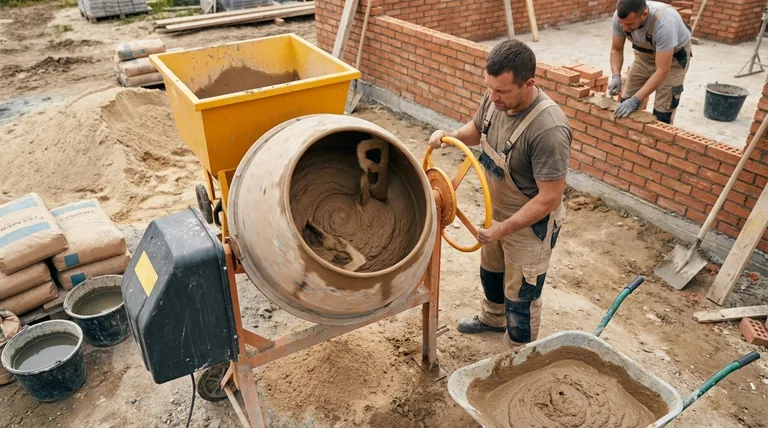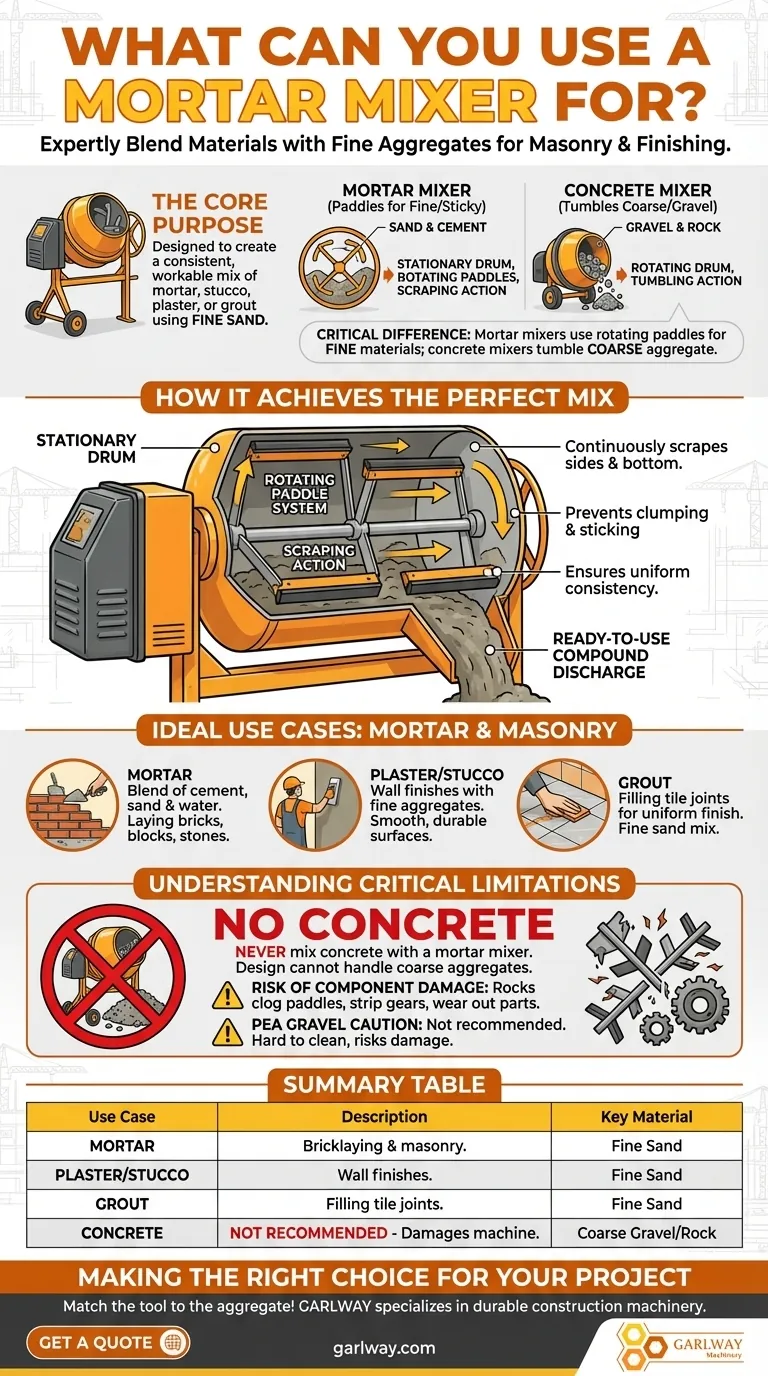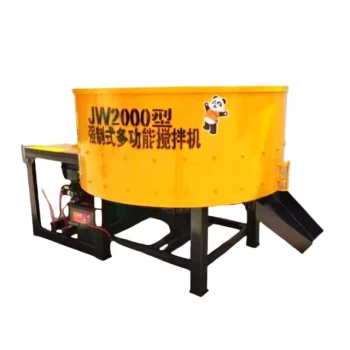At its core, a mortar mixer is a specialized tool designed for one primary purpose: to expertly blend materials with fine aggregates like sand. It is used throughout the construction industry to create a consistent, workable mix of mortar, stucco, plaster, or grout for masonry and finishing projects.
The critical difference between a mortar mixer and a concrete mixer lies in their design. A mortar mixer uses rotating paddles to thoroughly combine fine, sticky materials, while a concrete mixer tumbles coarse gravel and rock required for structural concrete.

How a Mortar Mixer Achieves the Perfect Mix
The effectiveness of a mortar mixer comes from its unique mechanical design, which is fundamentally different from that of a standard "cement mixer."
The Stationary Drum and Paddle System
Unlike a concrete mixer that tumbles materials in a rotating drum, a mortar mixer's drum is stationary. Inside, a set of horizontal paddles rotates through the material.
Scraping Action for Sticky Materials
These rotating paddles continuously scrape the sides and bottom of the drum. This action is essential for properly mixing thick, sticky materials like mortar and plaster, preventing them from clumping or sticking to the sides and ensuring a uniform consistency.
The Mixing Process
The operator loads the dry materials and water from the top of the tank. The paddles blend them thoroughly, and the final, ready-to-use compound is discharged from a central hole at the bottom.
The Right Tool for the Right Material
A mortar mixer excels when used for its intended applications, providing a higher quality mix for specific types of materials.
Ideal Use Cases: Mortar and Masonry
The most common use is mixing mortar—a blend of cement, sand, and water. This is the binding agent used to lay bricks, cinder blocks, and stones in all forms of masonry work.
Versatility with Plaster, Stucco, and Grout
The same mixing action that is perfect for mortar also makes it ideal for other fine-aggregate materials. This includes plaster and stucco for wall finishes and grout for filling joints.
Understanding the Critical Limitations
Using a mortar mixer for the wrong application is not just inefficient; it can actively damage the machine and lead to a poor-quality mix.
Why Concrete is Off-Limits
A mortar mixer should never be used to mix concrete. The design is simply not built to handle the coarse aggregates, like gravel and crushed rock, that give concrete its strength.
The Risk of Component Damage
Attempting to mix concrete can cause significant wear and tear. The large, coarse rocks can clog the paddles, strip pinion gears, and quickly wear out the rubber paddle strips designed for contact with sand.
Using Pea Gravel: A Cautionary Note
While some mixers can be adjusted to handle very small aggregates like pea gravel, it is not recommended. This practice makes the machine much more difficult to keep clean and still poses a risk of damage to the mixing components.
Making the Right Choice for Your Project
To ensure a quality result and protect your equipment, match the tool directly to the aggregate in your mix.
- If your primary focus is masonry, plastering, or stucco: A mortar mixer is the correct, purpose-built tool that will deliver the best and most consistent results.
- If your primary focus is creating concrete for footings, slabs, or posts: You must use a concrete mixer designed to handle the coarse gravel required for structural strength.
- If you are considering a single mixer for varied jobs: Understand that a mortar mixer cannot substitute for a concrete mixer's capabilities without risking severe damage.
Choosing the right mixer is fundamental to ensuring the integrity of your mix and the longevity of your equipment.
Summary Table:
| Use Case | Description | Key Material |
|---|---|---|
| Mortar | Mixing cement, sand & water for bricklaying and masonry. | Fine Sand |
| Plaster/Stucco | Blending materials for smooth, durable wall finishes. | Fine Sand |
| Grout | Creating a uniform mix for filling tile joints. | Fine Sand |
| Concrete | Not Recommended - Can damage the machine's paddles and gears. | Coarse Gravel/Rock |
Need the Right Mixer for Your Project?
GARLWAY specializes in durable construction machinery for professionals. Whether your project requires a reliable mortar mixer for perfect plaster or a robust concrete mixer for structural work, we have the equipment to ensure quality and efficiency.
Contact our experts today to find the perfect solution for your construction needs: Get a Quote
Visual Guide

Related Products
- JDC350 Small Cement Concrete Mortar Mixer
- Auto Concrete Cement Mixer Machine New
- Commercial Construction Mixer Machine for Soil Cement Mixing Concrete
- Construction Products Concrete Plant Machine Mixing Concrete Mixer
- Ready Mixer Machine for Construction Ready Mix Machinery
People Also Ask
- How much does a portable concrete mixer hold? A Guide to Choosing the Right Capacity
- How do I choose a cement mixer? Find the Perfect Match for Your Project Scale and Power Needs
- What are the 4 classifications of concrete mix? Choose the Right Mix for Your Project's Success
- Do you put water or cement in a cement mixer first? Master the Professional Layering Method
- How much weight can a cement mixer hold? A Guide to Choosing the Right Size for Your Project














